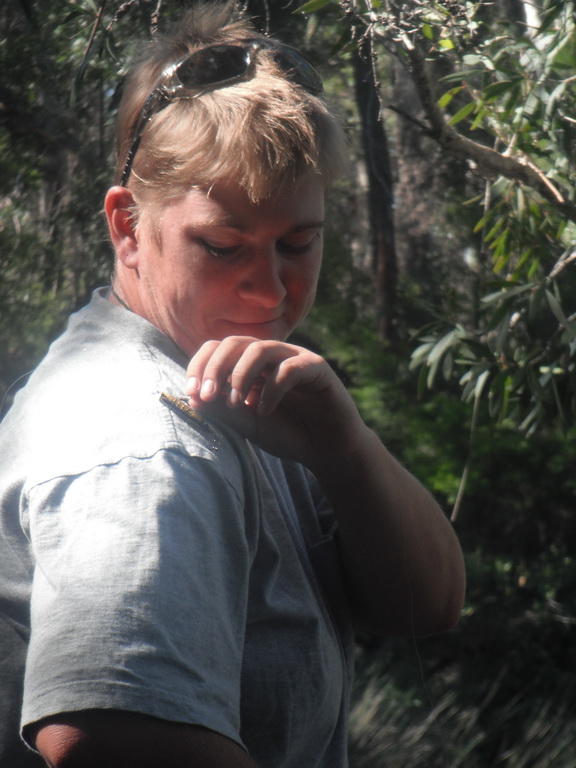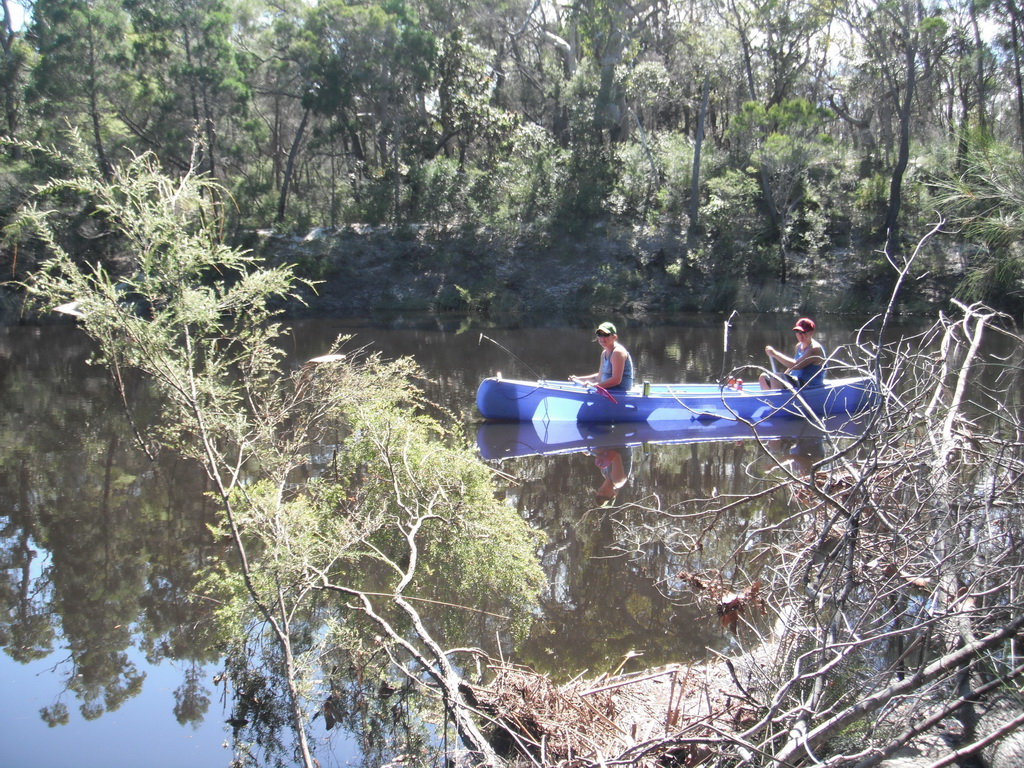Caught by a Lure

 “Bugger it’s got me” The sound of a fisher that’s just been hooked by their own lure.
“Bugger it’s got me” The sound of a fisher that’s just been hooked by their own lure.
Fishing in the Upper Noosa we only use lures. Mostly traditional lures, although we have tried various squidgy soft baits and this time around the girls have ornate spinner baits. The fact is that most success has been on standard lures.
Lures are a mixed blessing, they are ideal bait for fishing because you use them over and over and are just kept in a box. No need to keep messy, smelly live bait. The downside is each lure has two, three-pronged hooks that are razor-sharp. They snag your fingers, your clothes, the canoe, someone else hair, someone else’s shirt, the trees, almost anything and everything when it is the absolutely inconvenient.
Pickup your rod and move it and the next thing you know you have snagged the paddler in front of you, they are now stuck facing forward, because if they turn the lure and your line goes with them. Winding the line in only engages the hook even deeper into their clothing and squirming by the now caught paddler only embeds the hook in with more certainty. After all, that’s the purpose of lure design, isn’t it? If the front paddler has only a singlet on, chances are one of the six barbs will catch the skin and then mayhem is really on.
The owner of the rogue rod has a problem; the canoe by this time is free-floating down the river while its two occupants are struggling with a lure. The “owner” of the rod, of course, can’t reach the hocked buddy in the front because their paddling seats are more than an arm’s length apart. Reaching forward off the bum to remove the hook sets in motion a pantomime of unstable rocking of the fishing platform, both paddlers are now more concerned about not rolling the canoe than removing the lure. Unfortunately, the river is still flowing, the snags are still lurking under the water, and before you know it the whole circus has passed through a tree hanging with its branches in the river. The tree prior to your arrival was home to a thriving nursery of baby spiders who you have now released from their little web nests and they are all exploring this new world which is your head and face, down your neck and in your ears and eyes.
You can hear the screaming from the front of the canoe from the buddy who is still connected to your line by the back but seems more occupied by the new eight-legged menace than the six barbed plastic fish in their back.
 The canoe is still pushing through the under growth on the banks of the river until it comes to rest sideways against a log. Slowly, under the pressure of water is trying to bend itself around the log from the front and the back until it can no longer hold up and cracks into two and leaves its now soggy occupants scrambling to the shore for safety.
The canoe is still pushing through the under growth on the banks of the river until it comes to rest sideways against a log. Slowly, under the pressure of water is trying to bend itself around the log from the front and the back until it can no longer hold up and cracks into two and leaves its now soggy occupants scrambling to the shore for safety.
On the bank exhausted you realise that your buddy still has a lure in their back and after removing the barbs of the artificial bait, you still have your line and by pulling on the line you have managed to retrieve the 200 meters of fishing line with the rod. Success?
Well, that’s what could happen, but it didn’t. Our experience was more sedate with rear paddler under instructions from forward paddler, to use two orange fishing gloves to handle a fish she’d caught, unfortunately the fishing glove material is full of loops which invite the snagging of lures, and in this case she caught both gloves, she now has a fish in the middle and the gloves stuck together. Frustrated, she ends up discarding the fish and the offending glove still hanging from the fishing line overboard like some “Orange Hand” of the river gods.
The river gods are holding a fish aloft as if to say “’eres a fish for ya Matey”.
Lures get stuck everywhere, obviously casting is a prime time, up trees three and four meters above the river, you wonder what the heck happened as the “quick flick” flies off the real and into the riverside forest canopy. Now there is the issue of retrieving it. Sometimes you can flick it free, and sometimes you can , let it down over a branch and then cut the lure off and retrieve the line without it.
Flicking repeatedly from a bunch of reeds often generates a sudden release, and with a robust tug it ends up flying at the tugger, missing them or their canoe buddy within inches.
When your most expensive lure that’s just caught, five very large bass suddenly disappears into a tree overhanging high above the river always evokes the most irrational behaviour. Before you know it you’re mobilizing a rescue team dedicated to the recovery of your prize lure, frantically paddling towards the dangling artefact without fear or favour. Usually hanging temptingly close so that if one stood up in the canoe and stretched full length with a paddle in hand, it could almost be reached.
Of course, in these instances, less regard is given to craft stability or the continuous flow of the underlying river as it sweeps things such as canoes with people standing in them with outstretched arms downstream. Such rescues can end in results that are not necessarily anticipated.
Exactly this happened with the daughter’s “famous” lure, it had been cast in the aforementioned manner and had indeed spun a couple of times around a tree limb only to hang temptingly below the tree limb.
With person one in the rear of a canoe and and person two in the front as the canoe pilot, working from the front managed to hover under the valuable plastic object. Person one waggled our largest paddle defiantly at the lure, to no avail.
She decided to grab our largest as yet unused awning pole to see if the added length allowed a more positive result. Said pole acquired the girls head back to the action area and, using a hook on the side of the pole managed to flick the lure off the tree and retrieve it without harming anyone or yet anything.
Planning for a trip we spend a lot of time and money on selecting the correct lures. We arrive at the camp full of hope and expectation with lures of all shapes and sizes, colours, textures and rattles.
This trip saw the yellow and black rubber frogs, squidgy with secret super sauce attractant guaranteed to catch fish, spinner baits, all the rage with the “TV” fishermen, apparently ideal for deep water bass holding down.
The lure of the trip was one my daughter purchased; a hard lure for bass rated to dive up to six meters, coloured green and silver, this beauty caught some of the great fish, including the four largest fish with the biggest, coming in at 40 cm long. We didn’t unfortunately have a set of scales, so we didn’t know the weight.



The biggest was 40cm actually Dad. 😉
Duly noted and amended